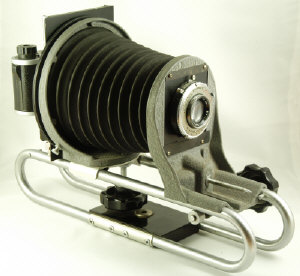This page was developed in collaboration with Randy McKinley, Ohio Camera
Collectors Society,
whose images appear below. The
comments and opinions are mine.
|
D R A F T
V E R S I O N |
||||
 |
|
|||
| Eastman Kodak had decades of experience designing medium and large format cameras when they introduced the Flurolite Enlarger in the 1950s and there are a number of earlier examples of cross-product compatibility and accessories that broadened the functionality of products. The Kodak Flurolite Camera is one of the more original of these efforts. Before the xerographic revolution took document imaging by storm, microfilm--most often on 35mm stock--was the accepted medium for providing archival images of business and legal documents. At least as far back as the late 1930s when Kodak introduced the original Kodak Ektra, there were accessories to support prosumer microfilming. The Precision Enlargers of that period could be fitted with film backs for 2 1/4 x 3 1/4 in, 6.5 x 9 cm, 3 1/4 x 4 1/4 in, 9 x 12 cm sheet film and adaptations of film bodies on adapter plates for 35mm and Bantam (828) film. The film backs were attached to the Precision bellows structure mounted on the enlarger stand. This assembly could be rotated 90° for copying of documents against an adjoining wall, but it remained a stand camera. Kodak offered dedicated commercial equipment in their Micro-File Recordak line. The novelty of the Flurolite design extended the idea of reusable modules by offering a more compact focusing rack on which the front and rear standards and bellows could be mounted. A plate on the bottom of the camera focusing rack is threaded for a standard 1/4 inch tripod mount. This provided several features of a medium format view camera. While front movements are not supported, rear swing of about 15° is possible. [Do I correctly assume that with the 35mm back, rear rise in landscape orientation or left/right shift in portrait orientation, but not both would be possible by positioning the film gate in less than a completely down position?] The configuration that uses 6.5 x 9 film [As noted in the Reference Manual and other Kodak publications, both 2 1/4 x 3 1/4 and 6.5 x 9 backs and holders were available for the Precision A. Was the Flurolite limited to only 6.5 x 9? I also wonder if the Precision adapters were unchanged for the Flurolite.] weighs XXX lbs. XX oz. without a lens, with dimensions of XX x XX x XX. While a collector will be much less concerned with the comparisons made in the rest of this article, I've approached it as a potential user with an interest in current use. |
||||
| |
The Flurolite bellows are molded rubber and were made to remain intact in the saturated air in darkrooms that often had its way with cloth bellows. Flurolite bellows compression was designed to support a 35mm frame so it should be possible to mount short focus lenses, for example a 47mm Super Angulon or something newer of that length. A large plastic knob under the camera locks the adjustable rear standard, so with short focus lenses, the front of the rack does not creep into the bottom of the frame. Maximum bellows extension is XXX inches, so the 203mm Ektar and some of the compact process lenses in the 250-300mm range come to mind. Lenses are mounted on flat boards 67mm square that were used by Precision and Flurolite enlargers. These are not difficult to make from 50 mil aluminum stock. The front standard mounts very solidly on the focusing rack, so heavy lenses can be used so long as the rear element fits through the lens port. [Can the standards be reversed so that the focusing knob is on the right?] | |
While the Flurolite Camera is limited in standards movements, the back attachments are versatile and compact. [Relevance of next info depends on whether there was a 2 1/4 x 3 1/4 adapter ] While the 6.5 x 9 cm single sheet film holders are compact, sheet film in this size is difficult or impossible to find. While 5 x7 nicely trims to 2 1/4 x 3 1/4, either 5 x 7 or 8 x 10 trims out to 6.5 x 9 with considerable waste. It might be possible to adapt a 2 1/4 x 3 1/4 Graflok or spring back to a plate that fits into the existing film gate. Kodak made ground glass focusing panels that were easily swapped in for composition. The 35mm back is a design that is similar to the earlier version for
the Precision Enlarger A--essentially the body of a Kodak 35 mounted on
the adapter plate for the enlarger. A special feature of the 35mm adapter
is that the film magazine and a ground glass focusing frame are mounted
on a sliding plate that allows them to be swapped, a design that still
exists in the Wista 4 x 5 line of 120 adapters. [Does
the Kodak model have an automatic dark slide? Any information to suggest
that Kodak was the first to use this design?] A pivoted metal
cover doubles as a ground glass focusing shade and a rear cover for the
ground glass panel. The bottom/back are removed for film loading. |
 |
|
| [I periodically check eBay for Kodak enlargers and Flurolites seem much less common than Precision As. I don't remember ever seeing either an entire Flurolite camera or the focusing rack. It would be nice to give at least some general idea of the rariety of this, having whetted appetites] | ||
|
|
|||
 08/04/2010 0:59 |
|
|||||